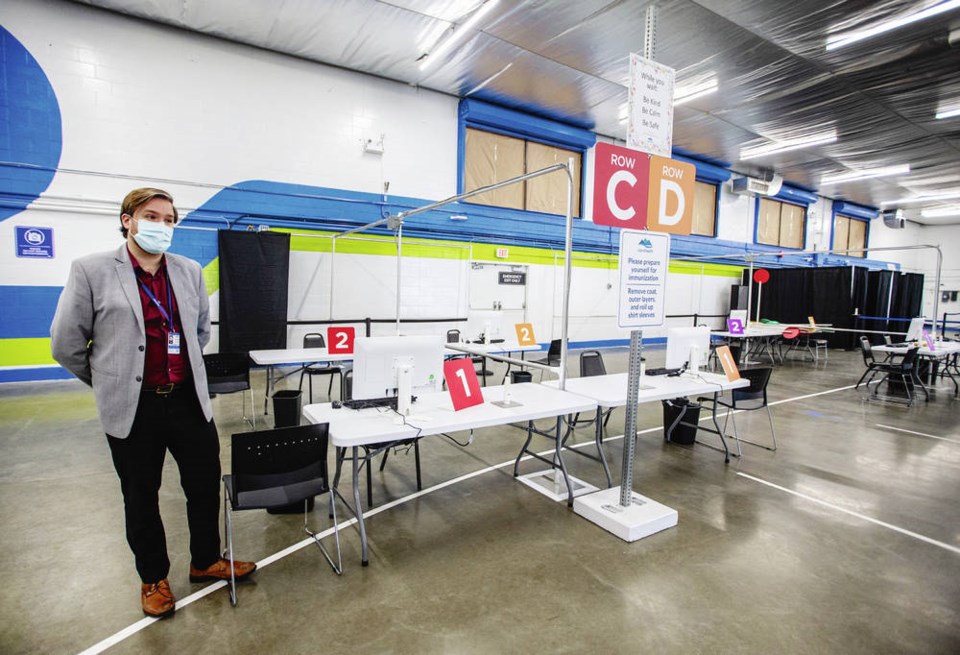VANCOUVER — A slowdown in the rate that British Columbians receiving their first dose of COVID-19 vaccinations leaves a significant gap for variants of the virus to take hold, even as officials hit new milestones for vaccination rates, according to infectious disease experts.
The province, on Friday, reported that 80.6 per cent of adults and 79.5 per cent of everyone over the age of 12 eligible for vaccination had received their first dose with full-vaccination rates hitting 49.9 per cent and 53.2 per cent, respectively.
However, the number of those eligible who aren’t immunized, “that’s huge, because that’s 20 per cent that is unvaccinated,” said Dr. Brian Conway, medical director of the Vancouver Infectious Diseases Centre.
“And then [there are] 10 per cent who are fully vaccinated that didn’t respond to the vaccine, because the vaccine doesn’t work 100 per cent of the time.
“So now we’re up to 30 per cent, and it might be higher than that, because the vaccine may not protect as well against the Delta and Lambda variants,” Conway added.
And even if vaccinated individuals are protected against serious illness, Conway said they can still act as vectors of the variants and infect people who are more vulnerable to COVID 19.
Health Minister Adrian Dix maintained last week that B.C.’s vaccination program continues to gain ground and hasn’t plateaued, having delivered 444,000 COVID vaccine doses, 47,000 of which were first doses the previous week.
To really gain ground, Conway said, the administration of doses should be about half first doses and half second doses, so “the numbers do not lie, the numbers show us clearly that we’ve plateaued in terms of first shots.”
And the wide variation of vaccination rates between local health areas, according to data compiled by the B.C. Centre for Disease Control, presents another concern.
“The chain is only as strong as its weakest link,” Conway said, “so if we have regions that are just half vaccinated, those would be the places where we would most readily see the variants taking hold.”
The densely populated neighbourhoods of Vancouver, for instance, had first-dose rates of 83 to 87 per cent, as of July 13, while the more sparsely populated Peace River North and South and Fort Nelson LHAs hovered between 51 to 53 per cent of eligible populations.
Modelling expert Sarah Otto, a mathematics professor in the University of B.C.’s zoology department, said B.C.’s data shows that local health areas with lower vaccination rates have had higher infection rates over the past few weeks.
And Conway added that travel from those regions to more populated regions, even with much higher vaccination rates, is where COVID-19 can regain ground.
In the U.S., for example, Conway said that COVID variants are taking hold in states with lower vaccination rates, “then it spreads to places like California as people travelled,” to the point that cities such as Los Angeles have had to reimpose public health measures.
So with Canadians travelling freely, “it would only be just a matter of time before it spreads to the big city,” Conway added, unless B.C. can use testing to quickly find and squelch transmission networks.
“We’re told [by provincial health officer Dr. Bonnie Henry] that we do have such an ability right now, because the case counts are low, but I would rather not have to test it,” he said.
Otto said what B.C. has to work with is the fact that the numbers of people actually resistant to vaccination are quite low. Just five per cent of eligible adults said they would adamantly not get vaccinated, according to an Insights West survey in June.
Otto added that B.C. has worked on increasing access, holding more pop-up clinics and opening up drop-in appointments for those receiving first doses, removing the barrier of registration.
She said that same Insights West survey showed that those who could have questions addressed by people they know were more likely to get vaccinated.
“I think we’re going to have to target more, you know, make it very easy for people to get vaccinated, to bring the vaccines to them and by people that they trust,” Otto said.
Conway said B.C. should set a deadline to significantly boost overall vaccination, first by blitzing all of the first-dose recipients who have already shown their eagerness to be immunized, with an emphasis on 12 to 17 year olds before school starts.
Then the province needs to identify who the 20-per-cent unvaccinated are, find out why they aren’t vaccinated and how to get the vaccine to them, whether it is through 24-hour vaccine-athons or better dialogue.
And Conway would give it “until Labour Day. I think that makes a nice sort of target (that is) far enough into the future that all of this is feasible, six-seven weeks,” with a considerable incentive.
That is when B.C. plans to lift more restrictions anyway, so “it will be hard to explain, for instance, why the Canucks can’t have fans this fall.”



